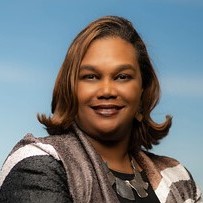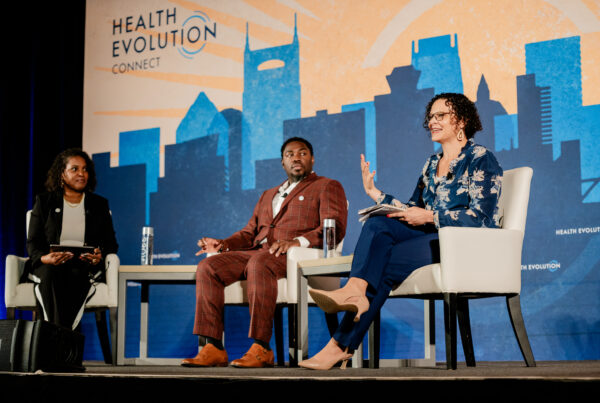Airica Steed, EdD, RN, FACHE, is the President & CEO of The MetroHealth System, Cuyahoga County’s safety-net health system serving more than 300,000 patients. Dr. Steed is a nationally recognized leader and advocate for building a more equitable health care system. She began her tenure at MetroHealth in December 2022 after serving in leadership roles in several health systems in Chicago.
Health Evolution interviewed Dr. Steed about her first year as President & CEO, her passion for health equity, MetroHealth’s leading health equity strategies, and her advice for peers.
Q: Dr. Steed, congratulations on your new role and welcome to the Health Evolution Fellowship. We are delighted to have your dedication and expertise in this community of cross-industry leaders. Let’s start with your move to Cleveland. What drew you to MetroHealth as the next step in your career? What have you learned as you’ve navigated your first year as CEO?
I am glad you asked “what drew me” because, that is what happened. I was truly drawn to MetroHealth and to Cleveland.
In many ways, MetroHealth is a lot like the health system I came from in Chicago. It is Greater Cleveland’s safety-net health system, completely dedicated to the community. We belong to the community.
And Cleveland is a lot like the neighborhood I grew up in, on the Chicago’s South Side. Cleveland has deep communities, wonderful people, and vibrant culture, yet at the same time, America’s health inequities and disparities are on display at every turn.
Cleveland was recently named the least livable big city in America for Black women. Black women are three times more likely than other women to die from pregnancy-related causes. In Cuyahoga County, Black babies die at nearly four times the rate of white babies.
In every broad health measurement – life expectancy, burden of disease, mental health, access to care, mortality – people of color in Cleveland get the tragic short end of the stick.
Working to fix this, that is my calling.
I was drawn to Cleveland, because health equity is MetroHealth’s calling, too.
Our system is hyper-focused on not just treating our patients, but hyper-focused on going beyond medicine to treat our entire community as our patient.
And what have I learned in my first 10 months as CEO?
So much.
I’ve learned that Cleveland gives newcomers a warm welcome. I feel right at home.
I’ve learned that MetroHealth’s employees not only share my passion for health equity, they inspire even more passion.
And I’ve learned that I get energy – I am fueled – by challenges, by headwinds and by naysayers. When you tell me something cannot be done, you are throwing another log on my fire.
Q: Let’s talk more about your dedication to fixing those stark disparities. Anyone who meets you knows you have an unwavering commitment to making health care more equitable. What fuels your passion for advancing health equity?
My passion is born from my own pain.
I lost my mother to a rare form of leukemia when I was just 23 years old, and she was 46. She was misdiagnosed, and our family was never informed about the risks – or about the truly inhumane side effects – of the aggressive experimental treatment she received.
Both of my grandmothers died of breast cancer. My maternal grandmother was misdiagnosed twice, and by the time her cancer was discovered, it had spread to her liver, kidneys, brain and bones.
My baby sister died of breast cancer, too, at the age of 39. She knew our family history and tried to get early screenings for breast cancer. But she was denied.
And my own life was at risk during pregnancy – twice – when I suffered preeclampsia, a dangerous elevation in blood pressure that affects Black women 60% more often than white women. Earlier this year, it stole the life 32-year-old Olympic Gold Medalist sprinter Tori Bowie.
My preeclampsia resulted in premature births of two of my children and weeks of separation as my babies struggled for survival. I struggled for survival, too.
Despite my diagnosis, I was not offered high-risk pregnancy care until it was too late, until my situation was critical. Only by the grace of God am I here today.
So this is personal for me. I am laser-focused on ending health disparities and zeroing out the death gap. I do not want my children – or anyone else’s children – to endure what me and my family, and so many families, have endured.
Q: Thank you for sharing such incredibly personal experiences. As someone who is so deeply passionate about reducing disparities—and has held leadership positions in several prominent health systems—what stands out to you about how MetroHealth approaches health equity work?
We recognized a long time ago that the work we need to do doesn’t occur within the four walls of our hospitals or health centers. It occurs outside of those walls, inside our community.
80% of what impacts our community’s health is deeply rooted in the community. That’s why we are addressing the social drivers of health. That’s why we opened the first high school in the nation located inside a hospital. That’s why we built an affordable-housing project directly on our main campus.
All of our approaches, all of our programming, speak to our efforts to boost health equity – our research and innovation, our economic investment in areas of our community that haven’t seen significant investment in decades.
We refuse to wait for our patients to come to us. We go to them.
In April, we hosted our Minority Men’s Health Fair. Nearly 1,000 individuals participated – 19 from just one men’s shelter in downtown Cleveland. We provided screenings, connected them with primary care providers, scheduled appointments – and built trust.
All summer long, we have been set up at the Cleveland Zoo on Mondays, when there is free entry, for our new Multicultural Children’s Health Fair & Expo. Again, we are meeting our patients where they are, connecting, boosting access, and building trust.
And at the end of September, we are hosting the first ever Multicultural Women’s Health Fair & Empowerment Expo. We are expecting 1,500 women to participate. In addition to health screenings and sessions, we are partnering to offer programming that empowers and elevates our region’s women, personally and professionally. This is about lifting the health and wealth of our community.
Q: Building on those examples, let’s talk more about specific programs at MetroHealth, where improving access and experience are core to advancing health equity. What does that look like in practice?
I love to talk about MetroHealth’s Institute for H.O.P.E. The “hope” stands for Health, Opportunity, Partnership and Empowerment.
The Institute was founded in 2019 with the single purpose of eliminating health inequity. It goes beyond medical treatment to improve the foundations of community health and well-being, so we can give our neighbors, particularly in underserved communities, what they need to live the healthiest lives possible.
The Institute is built around our understanding that Social Drivers of Health – non-medical factors like access to nutritious food, safe housing, reliable transportation, digital access and more – have a greater impact on health than just medical care.
We are in the process of screening ALL of our patients for the social factors that may put their health at risk. So far, we have screened more than 120,000 patients.
The Institute works closely with more than 100 local partners and agencies, including the Food Bank and Housing Authority, to connect individuals at risk directly with the services they need. And to follow up and make sure patients receive those services.
The Institute also works with medical providers and clinical departments to weave services and support into patients’ regular medical treatment. This includes our award-winning Food is Medicine program where community health workers collaborate with medical providers to support nutrition planning and healthy eating habits for at-risk patients.
Q: Looking externally, MetroHealth is an anchor institution in Cleveland and invests in the community to drive long-term change and development. What programs are you especially proud of—and what should other leaders learn from these experiences?
Again, we have so many, including a new affordable housing development directly on our Main Campus called Via Sana, Spanish for “healthy way.”
But I would really like to focus on perhaps my favorite, the one I’m most proud of: the Lincoln West School of Science and Health, which is a partnership with the Cleveland Metropolitan School District.
This is a high school located inside our main campus medical center. It is the first high school in the nation located directly inside a hospital.
In addition to completing a traditional high school curriculum, the students of Lincoln-West are matched with mentors at MetroHealth in occupations they dream of entering – whether it is becoming a neurosurgeon or an electrician, a Life Flight nurse or a cook. They are provided with the opportunity to become a Licensed Nursing Assistant while they are still in school, so they can work in that profession the minute they graduate. We also offer these students paid internships throughout our health system after they graduate and award four United Negro College Fund scholarships a year.
The students at Lincoln-West come from nine countries, and 50% of them are African American.
The graduation rate is above 90% – 20 percentage points above Cleveland’s other public high schools – and every single graduate every year the school has been in existence has been accepted to college or another post-secondary educational program.
Q: Finally, what advice do you have for leaders of organizations who are earlier on in their work to create a more equitable health care system? What do you think other leaders need to know to accelerate progress?
All leaders, no matter where they are in their career, need to realize that real progress is only possible through partnerships and collaboration.
It truly does take a village.
We need a comprehensive approach, and that means pulling as many chairs – and wheelchairs – as we can to the table.
Second, do not let the critics, the naysayers and the defeatists pull you down. Listen and learn from honest, good-intentioned criticism, but ignore the negativity.
If you can’t ignore it, use it as your fuel to work even harder.
And third, perhaps most important, I think leaders really need to listen. Actively listen. And by that, I mean to schedule time on their calendars to listen. Listen to their workers, listen to their patients, listen to their partners. Go out into the community and listen.
People will tell you what they need, what works, what needs to be changed and how they want to be led.










